Contents
- 1 What is Huayna Picchu Mountain?
- 2 Where is Huayna Picchu Mountain Located?
- 3 What is the Entrance to Huayna Picchu Mountain Like?
- 4 How Can I Purchase Huayna Picchu Mountain Tickets?
- 5 Book your Huayna Picchu Mountain hike with Happy Gringo Tours.
- 6 What is the Huayna Picchu Mountain Route Like?
- 7 What Are the “Stairs of Death” on Huayna Picchu Mountain?
- 8 What Can You See from Huayna Picchu Mountain?
- 9 What is the Altitude and Elevation of Huayna Picchu Mountain?
- 10 How Long Does It Take to Climb Huayna Picchu Mountain?
- 11 How Difficult is the Huayna Picchu Mountain Climb?
- 12 How Many Steps Are There Up Huayna Picchu Mountain?
- 13 What is the Temple of the Moon on Huayna Picchu Mountain?
- 14 What is the Difference Between Machu Picchu Mountain and Huayna Picchu Mountain?
- 15 Which is Better: Huayna Picchu Mountain or Machu Picchu Mountain?
- 16 Is It Worth Hiking Huayna Picchu Mountain?
- 17 Can You Climb Huayna Picchu Mountain Without a Guide?
- 18 How Should You Prepare for the Huayna Picchu Mountain Hike?
- 19 Is the Huayna Picchu Mountain Hike Safe?
- 20 When is the Best Time to Hike Huayna Picchu Mountain?
- 21 What is the Overall Description of Huayna Picchu Mountain?
- 22 Tours that include Huayna Picchu
What is Huayna Picchu Mountain?
Huayna Picchu, often written as Wayna Picchu, means “Young Mountain” in the Quechua language. It rises to approximately 2,720 meters (8,923 feet) above sea level, about 260 meters higher than the Machu Picchu citadel. The mountain appears prominently in the background of the classic panoramic photographs of Machu Picchu.
More information about: Machu Picchu Altitude
Archaeological evidence suggests that the Incas built temples, terraces, and stairways on the mountain’s slopes, possibly for astronomical and religious purposes. The climb to the top reveals not only magnificent natural landscapes but also remnants of Inca architecture that reflect their advanced engineering and spiritual devotion. One of the most mysterious sites on the mountain is the Temple of the Moon, a ceremonial cave that remains a subject of research and fascination.
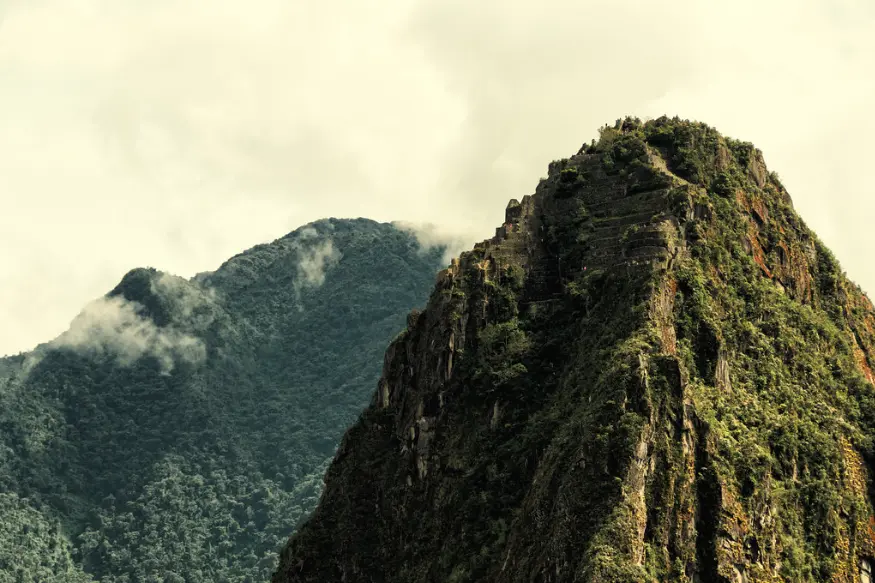
Where is Huayna Picchu Mountain Located?
Huayna Picchu is located in the Cusco region of southern Peru, within the Machu Picchu Archaeological Park. It rises immediately to the north of the citadel, forming the mountain that dominates the famous landscape seen in most photographs of Machu Picchu. To reach Huayna Picchu, travelers must first arrive at Aguas Calientes (Machu Picchu Pueblo), the small town at the base of the mountain, and then take a bus or hike up to the main entrance of Machu Picchu.
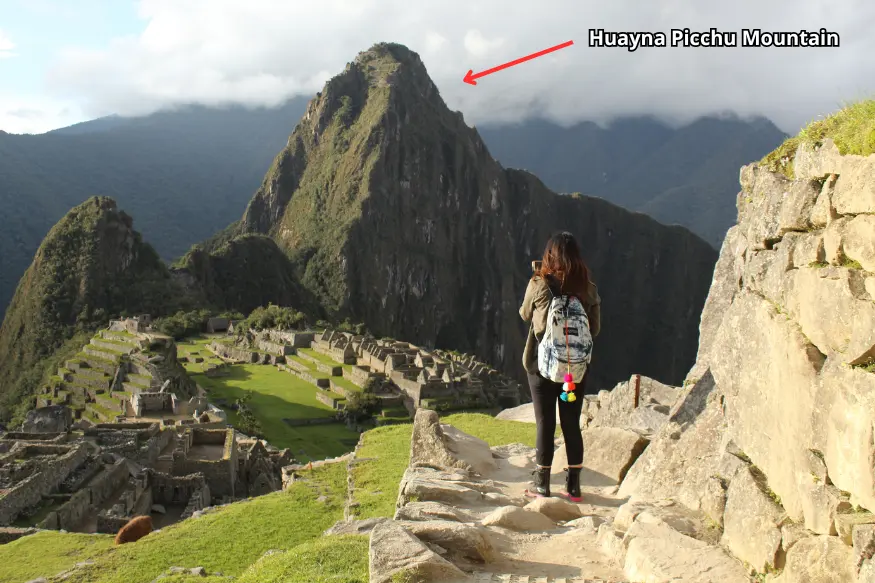
What is the Entrance to Huayna Picchu Mountain Like?
The entrance to Huayna Picchu Mountain is located within the Machu Picchu site, near the Sacred Rock area. Entry is restricted and regulated by the Peruvian Ministry of Culture.
Tickets for Huayna Picchu must be purchased in advance, as they are not available for purchase on-site on the day of the visit.
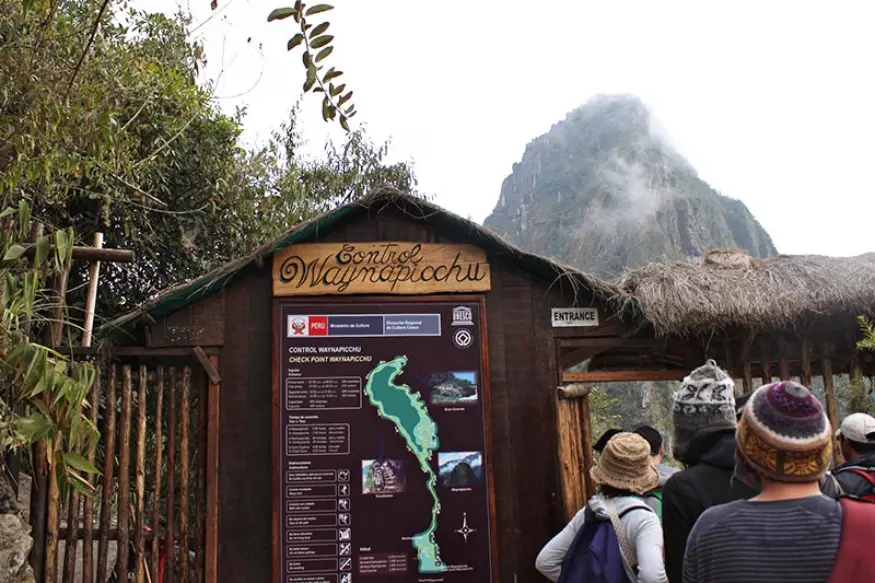
Entry Schedules
Access is organized into four different groups:
| Entry Group | Entry Time |
|---|---|
| Group 1 | 6:00 – 7:00 a.m. |
| Group 2 | 7:00 – 8:00 a.m. |
| Group 3 | 9:00 – 10:00 a.m. |
| Group 4 | 10:00 – 11:00 a.m. |
Each group is limited to 200 visitors, with a total of 800 people permitted to hike the mountain per day. During the high season, from May to September, tickets can sell out several months in advance.
More Information About: Best time to visit Huayna Picchu Mountain
How Can I Purchase Huayna Picchu Mountain Tickets?
To access this hike, travelers must purchase the “Machu Picchu + Huayna Picchu” ticket, which includes entry to both the archaeological complex and the mountain trail. Tickets are available on the official Machu Picchu government website or through authorized tour operators.
Ticket Prices (Approximate)
Foreign adult: USD 80–90
Student (with a valid ISIC card): USD 55–60
Peruvian citizens: Reduced local rates
Tickets are personal, non-refundable, and cannot be rescheduled. It is strongly recommended to plan and book as early as possible, especially during the dry season.
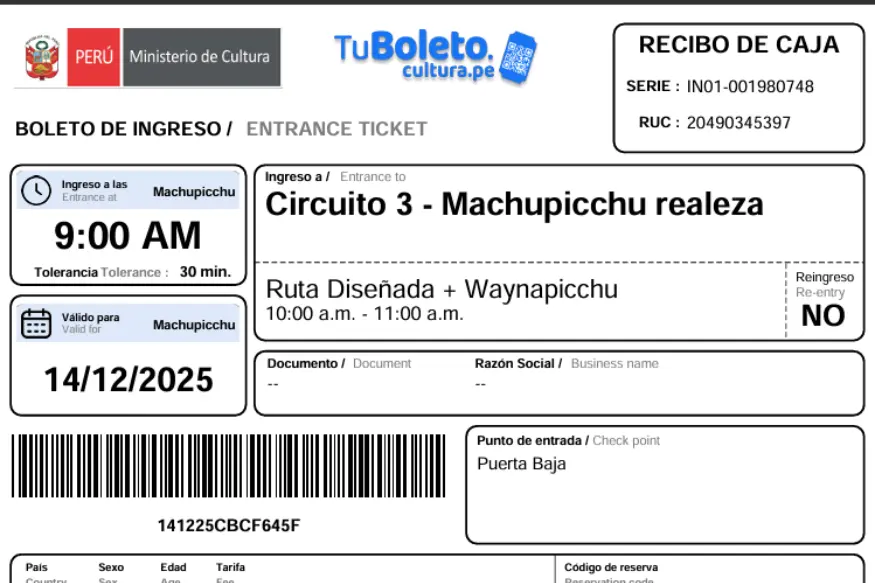
Book your Huayna Picchu Mountain hike with Happy Gringo Tours.
As an authorized local operator based in Cusco, we manage all the permits, tickets, and logistics for you, ensuring a smooth and stress-free experience. Our team will take care of every detail—from securing your Machu Picchu + Huayna Picchu entrance to arranging trains, buses, and guided visits—so you can simply enjoy your adventure
More information: Machu Picchu + Huayna Picchu Mountain Tour
What is the Huayna Picchu Mountain Route Like?
The Huayna Picchu Mountain Route begins near the Sacred Rock and follows a steep, winding path up the mountainside. The trail was originally built by the Incas and still features many of the original stone steps and narrow terraces carved into the rock.
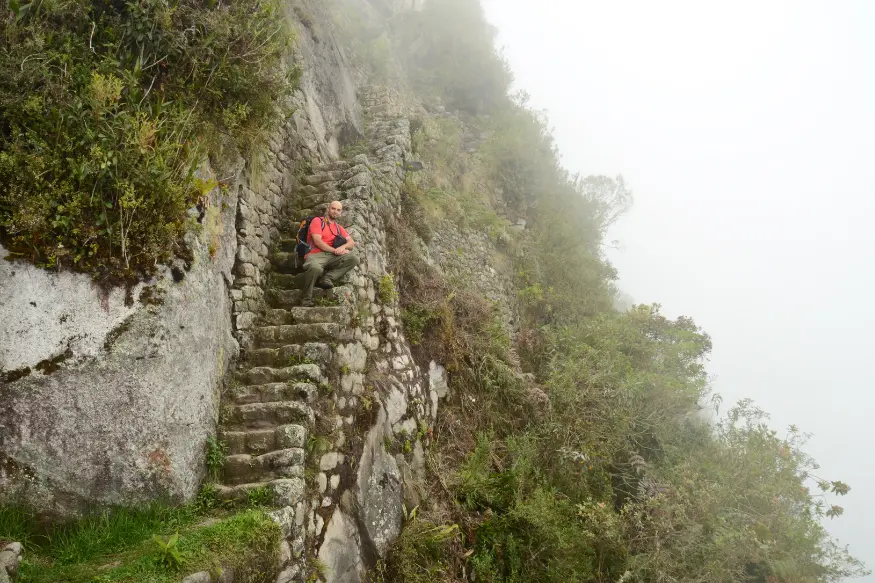
What is Route 3 of Huayna Picchu Mountain?
Route 3, also known as the Huayna Picchu Mountain Route, is one of the official visitor circuits. It includes:
A short exploration of the Sacred Rock area.
The entrance checkpoint for the Huayna Picchu trail.
The steep climb to the summit.
An optional detour to the Temple of the Moon.
The return path to the same entrance.
This route is considered moderate to difficult and is best suited for visitors with a reasonable level of fitness. It is not recommended for those who suffer from vertigo or fear of heights, as several sections run along exposed cliffs.
What Are the “Stairs of Death” on Huayna Picchu Mountain?
One of the most famous and talked-about parts of the hike is the section known as the “Stairs of Death”. This nickname refers to the extremely steep and narrow stone steps that descend dramatically along the mountainside. Despite the alarming name, the stairs are not truly dangerous for careful hikers, but they do require attention and balance.
These steps, built more than 500 years ago by the Incas, connect sacred points on the mountain and demonstrate their extraordinary engineering skills. The experience of climbing or descending them is intense and unforgettable, offering both challenge and exhilaration.
Travelers are advised to use both hands for support, wear hiking shoes with excellent grip, and proceed slowly, especially if the stones are wet due to rain or morning mist.

What Can You See from Huayna Picchu Mountain?
The view from Huayna Picchu Mountain is one of the most spectacular in the Andes. Upon reaching the summit, visitors can enjoy a panoramic perspective that includes:
The entire Machu Picchu citadel, perfectly framed by surrounding peaks.
The Urubamba River winds in a loop around the site.
Nearby mountains such as Putucusi and Machu Picchu Mountain.
The dense cloud forest vegetation is typical of the subtropical Andean region.
On clear days, the morning sunlight illuminates the ruins, revealing the intricate layout of the citadel and its harmony with the natural environment. Photographers and nature lovers often describe it as one of the most stunning views on Earth.
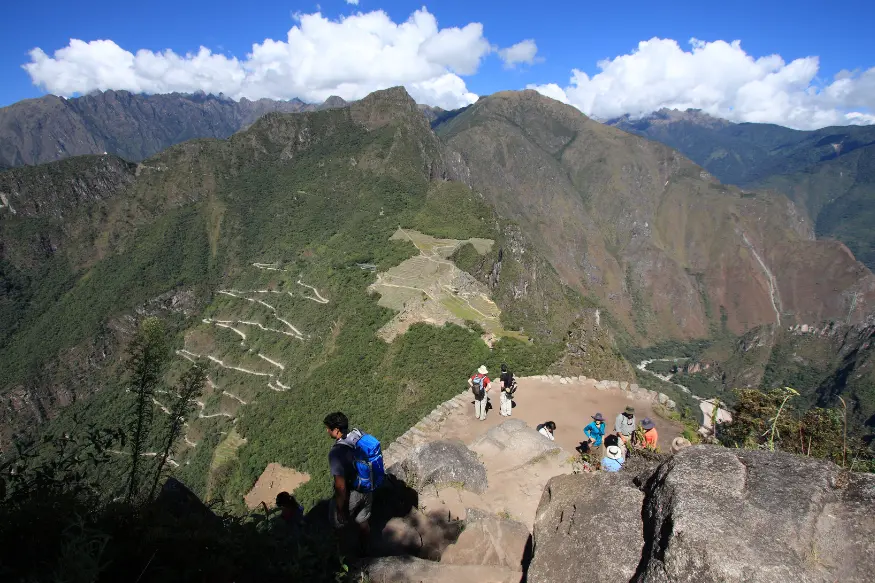
What is the Altitude and Elevation of Huayna Picchu Mountain?
Huayna Picchu reaches an elevation of 2,720 meters (8,923 feet) above sea level, while Machu Picchu stands at 2,430 meters (7,972 feet). Therefore, the total elevation gain during the climb is approximately 300 meters (around 1,000 feet).
Although this altitude is not extreme, some visitors may feel shortness of breath or fatigue due to the steep ascent. It is advisable to spend at least two or three days in Cusco or the Sacred Valley beforehand to acclimatize properly and avoid symptoms of altitude sickness.
How Long Does It Take to Climb Huayna Picchu Mountain?
The time required to complete the hike varies according to individual fitness and pace. On average:
Ascent: 45 to 90 minutes
Descent: 45 to 60 minutes
Total: 2 to 3 hours round trip
Allowing around four hours total provides enough time for rest stops, photos, and exploration of the summit ruins. The narrow path allows only one person to pass in some sections, which can slow progress, especially during peak hours.
How Difficult is the Huayna Picchu Mountain Climb?
The Huayna Picchu Mountain climb is considered moderate to challenging. The trail is relatively short but very steep, with sections that can feel almost vertical. It requires physical effort, good balance, and confidence at heights. However, it is achievable for most visitors in good health who take their time and proceed carefully.
The path is well maintained, and security staff are present throughout the area to assist hikers if necessary.
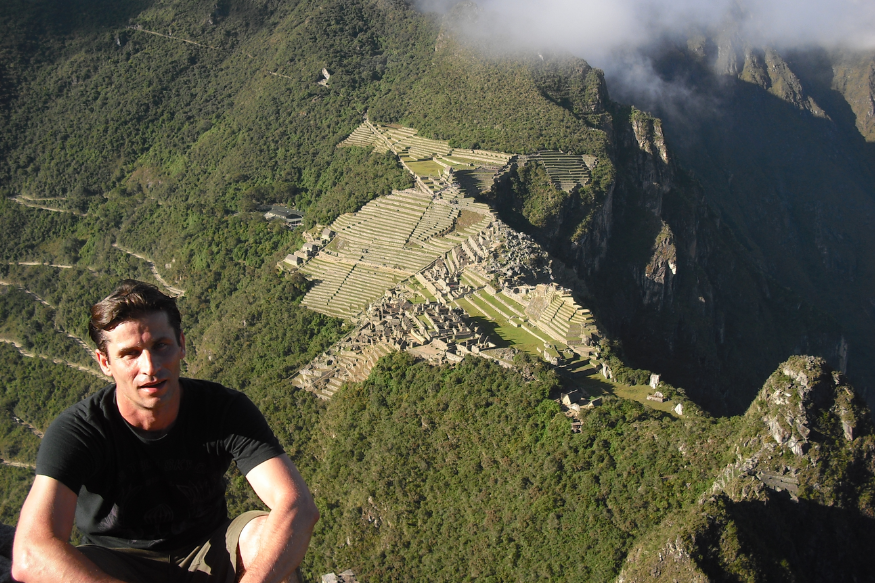
How Many Steps Are There Up Huayna Picchu Mountain?
There are approximately 1,000 to 1,200 steps carved into the rock leading to the top of Huayna Picchu. The steps vary in height and width, and many are uneven due to centuries of erosion. The steepest parts can feel demanding, but each section offers rewarding views and a sense of achievement.

What is the Temple of the Moon on Huayna Picchu Mountain?
The Temple of the Moon is a fascinating archaeological site located on the far side of Huayna Picchu. Built within a natural cave, it features finely polished stone walls and niches that may have served ceremonial or spiritual purposes. Scholars believe it was a place of ritual offerings or a site for worship related to the underworld.
Reaching the Temple of the Moon requires a longer detour from the main trail, adding about one hour to the hike. However, it is worth the effort for travelers seeking to explore a quieter and more mystical corner of the mountain.
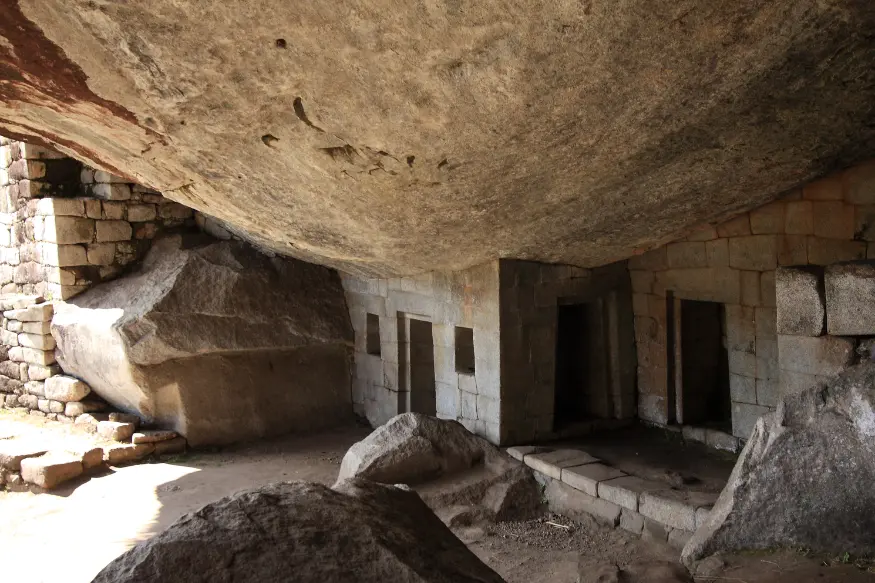
What is the Difference Between Machu Picchu Mountain and Huayna Picchu Mountain?
Many visitors confuse these two hikes, but Machu Picchu Mountain and Huayna Picchu are distinct experiences.
| Feature | Huayna Picchu | Machu Picchu Mountain |
|---|---|---|
| Altitude | 2,720 m (8,923 ft) | 3,082 m (10,111 ft) |
| Difficulty | Moderate to hard | Moderate |
| Trail length | About 2 km | About 3 km |
| Views | Overlooks the Machu Picchu ruins | Wider panoramic view of the Andes |
| Access point | Near the Sacred Rock | Near the main entrance to Machu Picchu |
| Daily limit | 400 visitors | 800 visitors |
Huayna Picchu offers a more vertical and adventurous experience, while Machu Picchu Mountain provides a longer, less steep climb with wider views of the surrounding mountains.

Which is Better: Huayna Picchu Mountain or Machu Picchu Mountain?
Choosing between the two depends on the type of experience desired.
Travelers who enjoy steep ascents, adrenaline, and ancient ruins will find Huayna Picchu more rewarding.
Those who prefer a longer but steadier hike and expansive vistas may choose Machu Picchu Mountain.
Both are excellent options, but the classic postcard view of the citadel is obtained from Huayna Picchu.
Is It Worth Hiking Huayna Picchu Mountain?
Yes, hiking Huayna Picchu is absolutely worth it. It offers a combination of adventure, history, and spirituality that few other hikes in the world can match. Standing at the summit while looking down at Machu Picchu is an emotional experience, connecting visitors with the ingenuity and devotion of the Inca civilization.
Although demanding, the sense of accomplishment at the top makes every step worthwhile. It is a once-in-a-lifetime experience for any traveler visiting Peru.
Can You Climb Huayna Picchu Mountain Without a Guide?
Yes, the hike can be done without a guide, as the trail is clearly marked and well monitored. However, hiring a licensed guide is highly recommended for those who wish to learn more about the archaeological features, the flora and fauna of the area, and the Inca history behind the mountain.
A knowledgeable guide can also assist with the steepest parts of the route and ensure that the hike is both safe and educational.
How Should You Prepare for the Huayna Picchu Mountain Hike?
To enjoy a safe and comfortable hike, it is advisable to bring:
Original passport (required for entry).
Printed or digital Huayna Picchu ticket.
Sturdy hiking shoes with good traction.
Light rain jacket or poncho.
Water and snacks in reusable containers.
Sunscreen, insect repellent, and a hat.
A camera or a phone for photographs.
Small backpack (large bags are not allowed).
Visitors should be in good physical condition and start the hike slowly to adapt to the altitude. Proper hydration and pacing are essential.
Is the Huayna Picchu Mountain Hike Safe?
Yes, the Huayna Picchu trail is safe when proper precautions are followed. The path is maintained regularly and supervised by park rangers. However, it is narrow and exposed in some sections, requiring attention and respect for the environment.
Safety guidelines include:
Avoid the hike in heavy rain or poor visibility.
Not carrying metal-tipped walking sticks.
Children under 12 are not allowed.
Once you exit the mountain, re-entry is not permitted.
Incidents are extremely rare, as the trail is well-regulated and visitors are briefed before entering.
When is the Best Time to Hike Huayna Picchu Mountain?
The dry season, from April to October, offers the best conditions for hiking Huayna Picchu. During these months, the sky is usually clear, the paths are dry, and visibility is excellent. The rainy season, from November to March, brings lush greenery but also slippery surfaces and occasional fog.
For those seeking the best light for photography, May and September are particularly ideal months, offering clear skies and moderate temperatures.
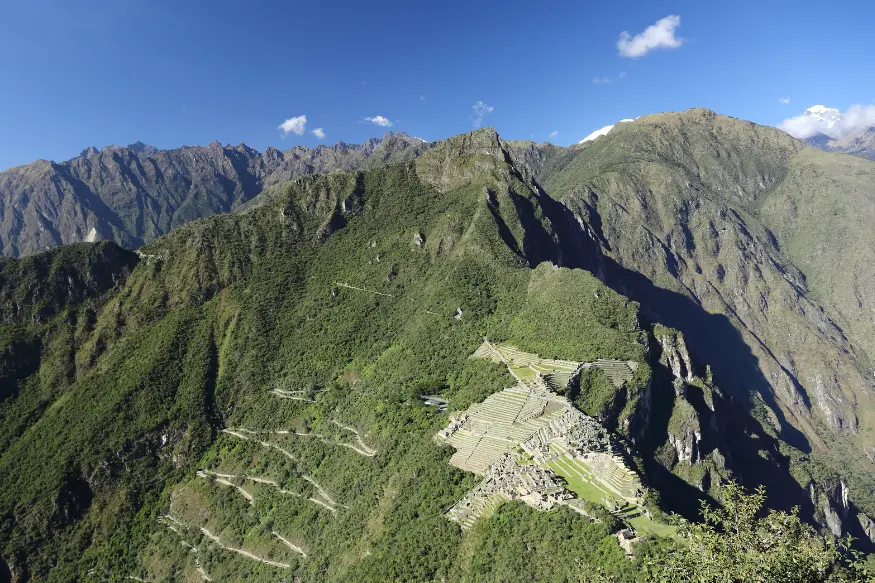
What is the Overall Description of Huayna Picchu Mountain?
The Huayna Picchu Mountain Hike is more than a climb; it is a journey through history and nature. It allows travelers to walk on ancient Inca paths, explore sacred sites, and admire one of the most spectacular landscapes in South America. The mountain’s unique combination of archaeological remains, stunning views, and natural beauty makes it one of the highlights of any visit to Machu Picchu.
Tours that include Huayna Picchu
You can add the Huayna Picchu Mountain hike to your Machu Picchu tours and other adventures such as the Inca Trail, Salkantay, or Lares Trek. This optional add-on lets you climb the iconic peak that rises behind the citadel, offering stunning panoramic views of Machu Picchu and the surrounding Andes. The additional cost is USD 75 per person, and tickets are limited, so we recommend booking in advance to secure your spot.
Classic Inca Trail Trek "The LEGENDARY stone paved Inka trail to Machu Picchu" is Peru’s number one Inca tours 4-Days tour.
View Tour →The trek from Lares to Machu Picchu 4 days is a spectacular way to visit one of The New Seven Wonders of the World - Machu Picchu. On the other hand, this impressive Lares trek from Cusco offers you unique opportunity to enjoy your Machu Picchu trek.
View Tour →Exploring Sacred Valley of the Inkas and Machu Picchu 2 days you will get to experience two of the most magical places of Peru, the Sacred Valley of the Incas and the Machu Picchu ruins.
View Tour →